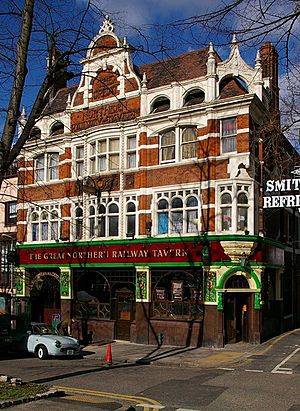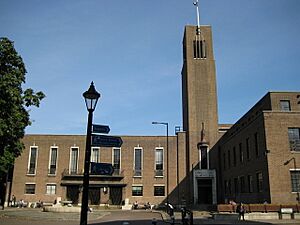Hornsey facts for kids
Quick facts for kids Hornsey |
|
|---|---|
 Great Northern Railway Tavern, Hornsey |
|
| Lua error in Module:Location_map at line 416: Malformed coordinates value. | |
| Area | 1.06 km2 (0.41 sq mi) |
| Population | 12,659 (2011 Census Ward only) |
| • Density | 11,942/km2 (30,930/sq mi) |
| OS grid reference | TQ305894 |
| • Charing Cross | 10 km (6.2 mi) South |
| London borough | |
| Ceremonial county | Greater London |
| Region | |
| Country | England |
| Sovereign state | United Kingdom |
| Post town | LONDON |
| Postcode district | N8 |
| Dialling code | 020 |
| Police | Metropolitan |
| Fire | London |
| Ambulance | London |
| EU Parliament | London |
| UK Parliament |
|
| London Assembly |
|
Hornsey is a cool part of north London, England. It's in the London Borough of Haringey. This area is mostly homes and is about 10 kilometers (6 miles) north of Charing Cross, a famous spot in London. Hornsey is close to some lovely green areas like Queen's Wood and Alexandra Park. A small river, the River Moselle, used to flow through here, but now it's underground. The oldest part of Hornsey is often called Hornsey Village.
Contents
Exploring Hornsey's History
Hornsey is a very old place. It started as a village that grew around Hornsey High Street. At one end of the High Street, you can find the churchyard and tower of the old St Mary's parish church. This church was first mentioned way back in 1291! At the other end of the High Street is Priory Park.
Hornsey High Street and St Mary's Tower
Hornsey High Street is a busy place with lots of shops, cafes, restaurants, and pubs. The oldest pub is called the Three Compasses. Some parts of the eastern High Street still have grassy areas.
The 13th-century St Mary's Tower is all that's left of the original St Mary's Church. The church was taken down a long time ago, and a new one was built. Later, the Victorian church was also taken down, and St Mary's school was built on the site.
The 500-year-old Tower has been fixed up and is now looked after by a group called Friends of Hornsey Church Tower. It's used for outdoor shows and concerts. The small space inside the tower, called The Intimate Space, is said to be London's tiniest performance area! It's a key spot for the Crouch End Festival, which holds a two-day music festival there. Hornsey Parish Church also has outdoor services at the Tower every Sunday.
Hornsey's Past and Name
The name Hornsey comes from the Saxon times. It means "Haering's enclosure," named after a Saxon leader called Haering. The name was first written down around 1195. Over time, it changed and gave us the names Harringay, the London Borough of Haringey, and Hornsey.
Hornsey Village grew a lot after 1860. It eventually joined up with another nearby settlement called Crouch End. This created the bigger urban area we see today.
Many of the buildings in Hornsey were built during the Edwardian period (early 1900s). The tower of the old parish church still stands in its ancient graveyard on Hornsey High Street. Other important buildings include the former Hornsey Town Hall in Crouch End.
Local Businesses and Growth
In 1870, the first shop of the David Greig grocery chain opened in Hornsey High Street. This chain was once a big competitor to Sainsbury's.
Did you know that the famous car company Lotus Cars started in Hornsey? In 1951, their first factory was set up in stables behind the Railway Hotel (now No5 Dining) on Tottenham Lane. The company was started by Colin Chapman. The pub was owned by Chapman's father! Lotus first sold cars to private racers. Their early road cars could even be bought as kits to save money. There's a special plaque near the old showroom to remember Colin Chapman.
Since the year 2000, many new homes have been built in Hornsey. These homes are designed in different styles and offer housing for many people, including some affordable homes.
Fun Things to Do in Hornsey
Hornsey has some great places for fun and relaxation.
Priory Park
Priory Park is the main park in the area. It's a big park, about 6.5 hectares (16 acres) in size. Two exciting events happen here every year: the YMCA Fun Run and Carter's Steam Fair. The park also has a cafe, a paddling pool for kids, and tennis courts.
The park first opened in 1896 as the Middle Lane Pleasure Grounds. More land was added in 1926, and the park was renamed Priory Park.
Hornsey Bowling Club
Hornsey also has a Bowling Club. It's a place where people can play bowls, a fun sport.
Churches and Mosques
Hornsey has several churches, including Hornsey Parish Church, Holy Innocents, Moravian, Middle Lane Methodist, St John The Baptist Greek Orthodox Church, and Campsbourne Baptist Church. There are also mosques in the area, like Wightman Road Mosque and Diyanet Camii.
Hornsey's Location
Hornsey is bordered by several other interesting areas in London.
- To the northwest is Fortis Green.
- To the north is Alexandra Park.
- To the northeast is Wood Green.
- To the west is Muswell Hill.
- To the east is Turnpike Lane.
- To the southwest is Highgate.
- To the south is Crouch End.
- To the southeast is Harringay.
Getting Around Hornsey
Hornsey is well-connected by public transport.
Train and Tube Stations
The East Coast Main Line train route, which goes from London King's Cross to northern England and Scotland, passes through Hornsey. You can catch local trains from Hornsey railway station to Central London (ending in Moorgate) and to Hertfordshire. The nearest Underground (tube) station is Turnpike Lane tube station on the Piccadilly Line.
Buses
Several bus routes serve Hornsey, including buses 29, 41, 141, 144, and W5. There are also night buses, N41 and N91, for late-night travel.
Schools in Hornsey
Hornsey has several schools for young people.
Secondary Schools
- Greig City Academy
- Hornsey School for Girls
- Highgate Wood Secondary School
Primary Schools
- Campsbourne Primary School
- St Mary's Primary School
Images for kids





